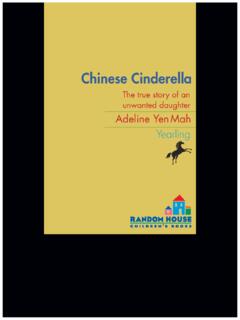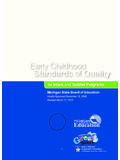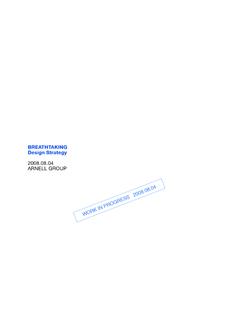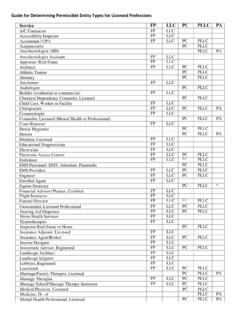Transcription of MALE AND FEMALE HE CREATED THEM ”
1 CONGREGATION FOR CATHOLIC EDUCATION(for Educational Institutions) MALE AND FEMALE HE CREATED THEM TOWARDS A PATH OF DIALOGUE ON THE QUESTION OF GENDER THEORY IN EDUCATIONVATICAN CITY 20193 INTRODUCTION1. It is becoming increasingly clear that we are now facing with what might accurately be called an educational crisis, especially in the field of affectivity and sexuality. In many places, curricula are being planned and implemented which allegedly convey a neutral conception of the per-son and of life, yet in fact reflect an anthropology opposed to faith and to right reason .1 The disorientation regarding anthropology which is a widespread feature of our cultural landscape has undoubtedly helped to destabilise the family as an institution, bringing with it a tendency to cancel out the differences between men and women, presenting them instead as merely the product of historical and cultural The context in which the mission of education is carried out is charac-terized by challenges emerging from varying forms of an ideology that is given the general name gender theory , which denies the difference and reciprocity in nature of a man and a woman and envisages a society with-out sexual differences, thereby eliminating the anthropological basis of the family.
2 This ideology leads to educational programmes and legislative enactments that promote a personal identity and emotional intimacy rad-ically separated from the biological difference between male and FEMALE . Consequently, human identity becomes the choice of the individual, one which can also change over time .23. It seems clear that this issue should not be looked at in isolation from the broader question of education in the call to love,3 which should offer, 1 Benedict XVi, Address to Members of the Diplomatic Corps, 10 January 2011. 2 Francis, Post-Synodal Apostolic Exhortation Amoris Laetitia, 19 March 2016, Cf. John Paul ii, Post-Synodal Apostolic Exhortation Familiaris Consortio, 22 November 1981, 6; Cf. John Paul ii, Letter to Families Gratissimam Sane, 2 February 1994, 4as the Second Vatican Council noted, a positive and prudent education in sexuality within the context of the inalienable right of all to receive an education that is in keeping with their ultimate goal, their ability, their sex, and the culture and tradition of their country, and also in harmony with their fraternal association with other peoples in the fostering of true unity and peace on earth.
3 4 The Congregation for Catholic Education has already offered some reflections on this theme in the document Ed-ucational Guidance in Human Love: Outlines for Sex Education .54. The Christian vision of anthropology sees sexuality as a fundamen-tal component of one s personhood. It is one of its mode of being, of manifesting itself, communicating with others, and of feeling, expressing and living human love. Therefore, our sexuality plays an integral part in the development of our personality and in the process of its education: In fact, it is from [their] sex that the human person receives the charac-teristics which, on the biological, psychological and spiritual levels, make that person a man or a woman, and thereby largely condition his or her progress towards maturity and insertion into society .6 As each person grows, such diversity, linked to the complementarity of the two sexes, allows a thorough response to the design of God according to the vo-cation to which each one is called.
4 7 In the light of this, affective-sex education must consider the totality of the person and insist therefore on the integration of the biological, psycho-affective, social and spiritual elements .85. The Congregation for Catholic Education, as part of its remit, wish-es to offer in this document some reflections which, it is hoped, can 16; Cf. John Paul II, General Audience, 8 April 1981 in Insegnamenti, IV/1 (1981), pp. second Vatican ecumenical council, Decl. On Christian Education, Gravissimum Educationis, 28 October 1965, congregation For catholic education, Educational Guidance in Human Love, Outlines for Sex Education, 1 November congregation For the doctrine oF the Faith, Persona Humana, Declaration on Certain Questions Concerning Sexual Ethics, 29 December 1975, 1. 7 Educational Guidance in Human Love, Outlines for Sex Education, Ibid.
5 , and support those who work in the education of young people, so as to help them address in a methodical way (and in the light of the uni-versal vocation to love of the human person) the most debated questions around human The methodology in mind is based on three guiding principles seen as best-suited to meet the needs of both individ-uals and communities: to listen, to reason and to propose. In fact, listening carefully to the needs of the other, combined with an understanding of the true diversity of conditions, can lead to a shared set of rational elements in an argument, and can prepare one for a Christian education rooted in faith that throws a new light on everything, manifests God s design for man s total vocation, and thus directs the mind to solutions which are fully human .10 6. If we wish to take an approach to the question of gender theory that is based on the path of dialogue, it is vital to bear in mind the distinction between the ideology of gender on the one hand, and the whole field of research on gender that the human sciences have undertaken, on the other.
6 While the ideologies of gender claim to respond, as Pope Francis has indicated, to what are at times understandable aspirations , they also seek to assert themselves as absolute and unquestionable, even dictating how children should be raised ,11 and thus preclude dialogue. However, other work on gender has been carried out which tries instead to achieve a deeper understanding of the ways in which sexual difference between men and women is lived out in a variety of cultures. It is in relation to this type of research than we should be open to listen, to reason and to Against this background, the Congregation for Catholic Education has seen fit to offer this text to all who have a special interest in edu-cation, and to those whose work is touched by the question of gender theory. It is intended for the educational community involved in Catholic 9 Cf. Ibid., 21-47, in which the Christian vision of sexuality is set second Vatican ecumenical council, Pastoral Constitution on the Church in the Modern World, Gaudium et Spes, 7 December 1965, Amoris Laetitia, , and for all who, animated by the Christian vision of life, work in other types of school.
7 The document is offered for use by parents, stu-dents, school leaders and personnel, bishops, priests, religious, ecclesial movements, associations of the lay faithful, and other relevant bodies. 67 LISTENINGB rief Overview8. The primary outlook needed for anyone who wishes to take part in dialogue is listening. It is necessary, above all, to listen carefully to and understand cultural events of recent decades. The 20th century brought new anthropological theories and with them the beginnings of gender theory. These were based on a reading of sexual differentiation that was strictly sociological, relying on a strong emphasis on the freedom of the individual. In fact, around the middle of the last century, a whole series of studies were published which accentuated time and again the role of external conditioning, including its influence on determining personality.
8 When such studies were applied to human sexuality, they often did so with a view to demonstrating that sexuality identity was more a social construct than a given natural or biological These schools of thought were united in denying the existence of any original given element in the individual, which would precede and at the same time constitute our personal identity, forming the necessary basis of everything we do. According to such theories, the only thing that matters in personal relationships is the affection between the individuals involved, irrespective of sexual difference or procreation which would be seen as irrelevant in the formation of families. Thus, the institutional model of the family (where a structure and finality exist independent of the subjective preferences of the spouses) is bypassed, in favour of a vision of family that is purely contractual and voluntary.
9 10. Over the course of time, gender theory has expanded its field of ap-plication. At the beginning of the 1990 s, its focus was upon the possibility of the individual determining his or her own sexual tendencies without having to take account of the reciprocity and complementarity of male-fe-male relationships, nor of the procreative end of sexuality. Furthermore, 8it was suggested that one could uphold the theory of a radical separation between gender and sex, with the former having priority over the latter. Such a goal was seen as an important stage in the evolution of humanity, in which a society without sexual differences could be In this cultural context, it is clear that sex and gender are no longer syn-onyms or interchangeable concepts, since they are used to describe two different realities. Sex is seen as defining which of the two biological categories (deriving from the original feminine-masculine dyad) one be-longed to.
10 Gender, on the other hand, would be the way in which the differences between the sexes are lived in each culture. The problem here does not lie in the distinction between the two terms, which can be inter-preted correctly, but in the separation of sex from gender. This separation is at the root of the distinctions proposed between various sexual orienta-tions which are no longer defined by the sexual difference between male and FEMALE , and can then assume other forms, determined solely by the individual, who is seen as radically autonomous. Further, the concept of gender is seen as dependent upon the subjective mindset of each person, who can choose a gender not corresponding to his or her biological sex, and therefore with the way others see that person (transgenderism). 12. In a growing contraposition between nature and culture, the propo-sitions of gender theory converge in the concept of queer , which refers to dimensions of sexuality that are extremely fluid, flexible, and as it were, nomadic.









